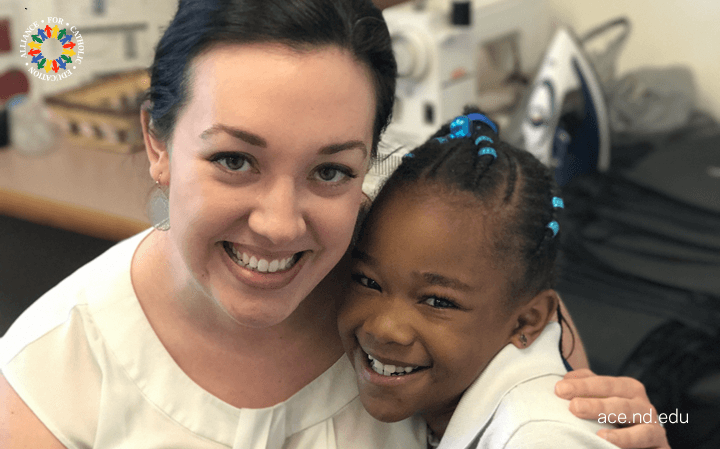Almost every day, I explain blended learning and how it can be implemented to different teachers, leaders, and administrators. For some, it is extremely difficult to understand this innovative way of teaching and learning, and it takes a high level of support from me and others to make sure they fully understand the concept and integrate it into their classrooms. For others, blended learning is a total "no-brainer" that immediately makes sense and quickly becomes second nature to them. Rachel Edelman is, without a doubt, part of the latter group.
After teaching fourth- and fifth-grade students in Boston for five years and graduating from the Mary Ann Remick Leadership Program, Rachel joined the ACE team as one of two Regional Directors of School Culture for the Notre Dame ACE Academies in Indianapolis. In this role, Rachel spends every day in the schools serving as a coach for school leaders and supporting the academic and cultural development of the schools more broadly. Holy Angels Catholic School is one of the three Notre Dame ACE Academies that Rachel serves, and she has been an invaluable resource to our blended-learning team as well as the teachers at Holy Angels during this implementation.
Prior to this school year, though, Rachel had only a basic understanding of blended learning. "I tried to use some software programs in my class last year, but I didn't have any training or guidance so it was very limited," Rachel explained. "I also did not have a strong understanding of how to fully use the data from the programs to inform my instruction."
Throughout our conversation, Rachel kept returning to this same point: data. In participating in our blended-learning training and working with the teachers at Holy Angels this year, Rachel has realized just how critical it is that teachers understand how to analyze and utilize data, both from the software programs and from other sources.

One of the first steps teachers can take to fully understand data from the software programs is to determine what information will actually be useful to them and where to find it. "It's very easy to get lost in the amount of information a software program provides. It's important to figure out which reports you need to best serve your students," Rachel says. She recalls data-reflection guides that I provided to teachers at the beginning of the year as important tools to help teachers understand where and how to start.
But once teachers know how to make sense of the data available to them, they also need to become critical users that inform the data from the software programs with data from the classroom, their experiences with the students, and their own expertise. "I remember talking to one teacher about two students in his class–one with remarkably high growth and one sadly with low growth. He gave me background information about the two students' very different home lives, work patterns, and class behaviors and told me how he thought this information related to the data from the software program," Rachel says. "And I think that's what it's really all about–understanding all the different factors that go into the data you see."
If teachers can become confident interpreters of data from the software programs, it can have an enormous impact on student learning and classroom culture. Rachel loves that teachers in a blended-learning model have access to accurate data about student performance every day rather than once a quarter so they can see exactly what students are missing and mastering.
She has also been impressed with the ways in which teachers at Holy Angels have used data to empower students by showing students how the work they do every day impacts their long-term growth. "In this model, students see proof of their hard work paying off," she says. Perhaps most importantly, this allows teachers to shift the focus from achievement to growth, which is particularly important in developing students' growth mindsets. "Even students that have not felt success before get to celebrate their progress when they're mastering content at the level that's right for them."
But when I asked Rachel about the keys to successful blended-learning programs, she actually cited growth mindsets for teachers. "Teachers need to know that this is NOT easy at first," Rachel explained, "There is a steep learning curve, and they need to be open to feeling frustrated and overwhelmed." Having said that, Rachel also encouraged teachers to "trust the process. Understand that this is not an overnight transformation, but don't give up. Just wait for it to take, it will be worth it."
We are so grateful to Rachel for sharing her experience and advice with the Higher-Powered Learning community. If you would like to get in touch with Rachel, you can contact her at redelman@nd.edu.
 Alliance for Catholic Education
Alliance for Catholic Education
